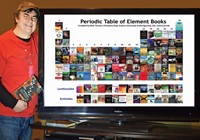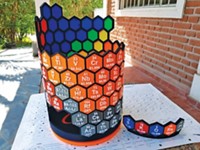Advertisement
Grab your lab coat. Let's get started
Welcome!
Welcome!
Create an account below to get 6 C&EN articles per month, receive newsletters and more - all free.
It seems this is your first time logging in online. Please enter the following information to continue.
As an ACS member you automatically get access to this site. All we need is few more details to create your reading experience.
Not you? Sign in with a different account.
Not you? Sign in with a different account.
ERROR 1
ERROR 1
ERROR 2
ERROR 2
ERROR 2
ERROR 2
ERROR 2
Password and Confirm password must match.
If you have an ACS member number, please enter it here so we can link this account to your membership. (optional)
ERROR 2
ACS values your privacy. By submitting your information, you are gaining access to C&EN and subscribing to our weekly newsletter. We use the information you provide to make your reading experience better, and we will never sell your data to third party members.
Education
Newscripts
Elemental Purchasing Power
by Sarah Everts
March 12, 2007
| A version of this story appeared in
Volume 85, Issue 11

Elemental Purchasing Power
Have you ever loved an element? Really, really loved an element, with such passion that you wanted to buy it for you and only you?
Perhaps it's that je ne sais quoi odor. Or the late-night encounter at the lab bench back in '89. The relationship may be volatile, but dang it, you're hooked. So what to do?
Newscripts advises a trip to Kalamazoo, Mich. Specifically, to the mural at the front entrance of Western Michigan University's newly built chemistry teaching facility.
There, you can buy your special element and simultaneously support a fund to help students in emergency situations.
The idea is simple, explains Michael J. Barcelona, chair of WMU's chemistry department. The revenue from the ELEMENT SALE flows into a departmental discretionary fund that helps students continue their studies even when facing major personal or financial obstacles.
A given element's cost is dictated by biological necessity. Bulk essential elements like H, C, N, and O go for $5,000. Trace essentials like Ca, K, and P cost $1,000, as do noble gases, transuranics, and unnamed predicted elements. Precious metals are a hefty $10,000. All other elements go for the discounted rate of $500.
WMU initiated the student security-blanket fund in 2005. At the time, the periodic table in WMU's old chemistry building was made from a 4- by 8-foot piece of plywood, and the signal of a sale was a paper tacked on at the appropriate element. Along with WMU's recently minted chemistry building comes a 10- by 25-foot mural entitled "Knowledge Made Matter" made by local artists using photolithography. Elemental ownership is now broadcast by a classy plaque.
Twenty-one elements have already been sold, raising more than $20,000, Barcelona says. The first recipient of money from the cash pool was an international student who found himself in Italy when his last surviving relative passed away in Kenya. This student had to travel to Kenya to take care of the burial, settle financial matters, and then apply for a visa to return to Michigan to finish his studies. "Most grad students would not be able to pull this off financially," says Barcelona. "He was most deserving of the first payout."
Worthy cause notwithstanding, Newscripts has taken a keen interest in the rationale of elemental purchase. Why buy seaborgium? Why not xenon?
Barcelona says he purchased cobalt for himself because it comes from the German word Kobolt or Kobold, which means goblin or leprechaun. "If you saw me, you would figure out why this fits," he tells Newscripts.
A group of faculty members bought ruthenium in honor of a colleague who studied ruthenium complex and had recently passed away. One avid comic book fan bought krypton, choosing to inscribe "Clark Kent and Lois Lane" on the plaque.
But many purchases remain a mystery. Why has someone purchased hafnium? To become whole? Or is there something about its metallic luster? As for the scandium sale, Newscripts will not even speculate.
Another big question is why no one has purchased carbon. Organic chemists, step up to the plate already! Is carbon too ho-hum to buy? Or perhaps it's quite the opposite: Are potential purchasers worried that nabbing carbon is distastefully hegemonic? Maybe it's just the $5,000 price tag.
Newscripts' curiosity about buyer motivation is voracious. There are seemingly endless avenues of speculation: One colleague created an entire field of sociological study with the query, "What kind of person buys an actinide?"
Readers wishing to meditate with Newscripts on such elemental issues can access the fundraiser at www.wmich.edu/chemistry/fundraiser.htm.
This week's column was written by Sarah Everts. Please send comments and suggestions to newscripts@acs.org.





Join the conversation
Contact the reporter
Submit a Letter to the Editor for publication
Engage with us on Twitter